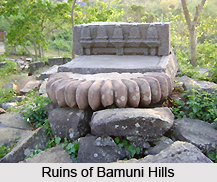 Tezpur town in Assam is located amidst tea gardens and military cantonments on the north bank of the Brahmaputra River which is 181-km northeast of Guwahati. The little town of Tezpur is surrounded with several lakes that stand on the site of Sonitpur. Tezpur is surrounded by hills of Arunachal Pradesh, peaks of Himalayas as the northern backdrop, tea gardens and archaeological ruins etc. Literally meaning "full of Blood", it is named after a mythical battle between Lord Vishnu and Lord Shiva.
Tezpur town in Assam is located amidst tea gardens and military cantonments on the north bank of the Brahmaputra River which is 181-km northeast of Guwahati. The little town of Tezpur is surrounded with several lakes that stand on the site of Sonitpur. Tezpur is surrounded by hills of Arunachal Pradesh, peaks of Himalayas as the northern backdrop, tea gardens and archaeological ruins etc. Literally meaning "full of Blood", it is named after a mythical battle between Lord Vishnu and Lord Shiva.
History of Tezpur
Tezpur, earlier known as Sonitpur, is a city steeped in mythology, legend and folklore. The City of Blood (`Sonit` of `Tez` - Blood, `Pur` - city) conjures up images of the romantic legend of Usha and Aniruddha and of the fierce battle between "Hari" and "Hara". Old Darang became today`s Sonitpur - Tezpur being the district Headquarters of Sonitpur.
According to the legend, Darang was the capital of demon King Banasura, an ardent follower of `Bhairavnath`, incarnation of Lord Shiva. Usha, the beautiful daughter of King Bana happened to see her love in her dream. Following the description of Usha, her confidante Chitralekha portrayed it in painting. The lover was none other than Aniruddha, Grandson of Lord Krishna, King of Dwarka, who was finally discovered and the wedding of Usha and Aniruddha took place according to `Gandharva` tradition.
 When it came to the knowledge of Bana he sent Aniruddha to prison. To rescue his grandson Sri Krishna came from Dwarka. In response to the call of his devotee Bana, Shiva also came there. When the appeal for rescue failed and sword fight was ensured between Hari (Lord Krishna) and Hara (Lord Shiva in the form of Banasura), then it resulted in bloodshed in the entire town.
When it came to the knowledge of Bana he sent Aniruddha to prison. To rescue his grandson Sri Krishna came from Dwarka. In response to the call of his devotee Bana, Shiva also came there. When the appeal for rescue failed and sword fight was ensured between Hari (Lord Krishna) and Hara (Lord Shiva in the form of Banasura), then it resulted in bloodshed in the entire town.
Since then the town has been named as Sonit or Tezpur meaning "A blood stained town". Bana was vanquished and Usha and Aniruddha were united forever. Usha and Aniruddha settled on the Bamuni hill, 5-km away from the city. The ruins and remains of "Agnigarh" where the immortal romance blossomed still bear mute testimony of this legend.
Along with legends Tezpur also has some historical rock edicts of 829 AD. It had been a major kingdom of Gupta Dynasty who ruled over the area for centuries.
Geography of Tezpur
Tezpur has some of the most fast moving rivers of north eastern India. Because of terrain these move fiercely towards the foot hills of Himalayan mountain range. Surrounded with some picturesque hillocks this is one of the most artistic towns of Assam.
Climate of Tezpur
Climate of Tezpur is warm and summers have generally much rainfall compared to winter. The region is classified as Cwa by Koppen and Geiger. The average temperature in summer is around 28.5 degree centigrade and the average winter temperature is around 17 degree centigrade. The place experiences severe winter during the month of January.
 Culture of Tezpur
Culture of Tezpur
Tezpur`s contribution to art, culture, literature particularly to the freedom struggle has earned a unique niche in the history of Assam. Chandra Kumar Agarwalla, Ananda Agarwalla, Dandi Kalita and a score of others enriched Assamese literature. Writer of "Rup Konwar", Jyoti Prasad the doyen of Assamese art and culture was an artist, poet, literature, dramatist, lyricist, filmmaker and a fearless freedom fighter.
Education of Tezpur
The central university here is known as Tezpur University. Tezpur also has a number of schools and colleges. Darrang College and Tezpur College are some of the most prominent ones. Along with this the place is also known for the training centers of Indian Army, and Indian Air force.
 Tourism in Tezpur
Tourism in Tezpur
Tezpur has some of the most prominent tourist spots. Among them the notable ones are Nehru Maidan, Chitralekha Udyan, the Mahabhairav Temple, Agnigarh, Da-Parbatia, Bamuni Hills, the Hazara Pukhuri , Cole Park, Bhalukpong, Eco Camp, Bhomoraguri, The Nameri Tiger Reserve, Orang Wildlife Sanctuary and Kaziranga National Park etc.
Visiting Information to Tezpur
Dekargaon Railway Station and Tezpur Airport are the nearest to reach the town. National Highway 27 connects this town to other parts of Assam.



















